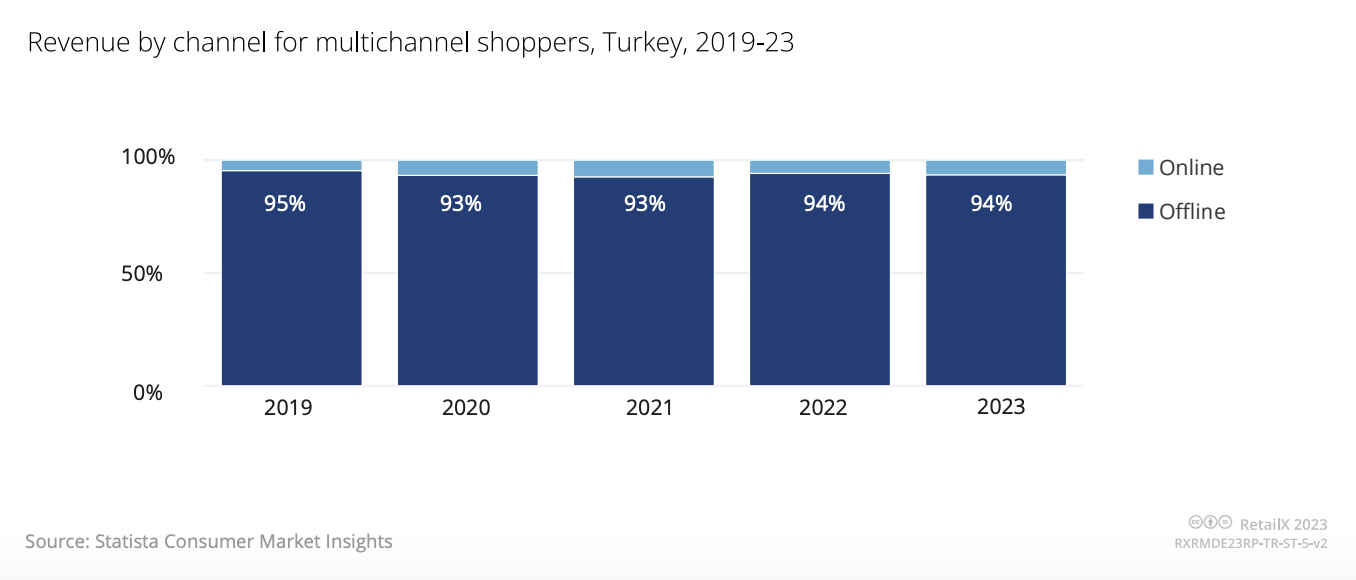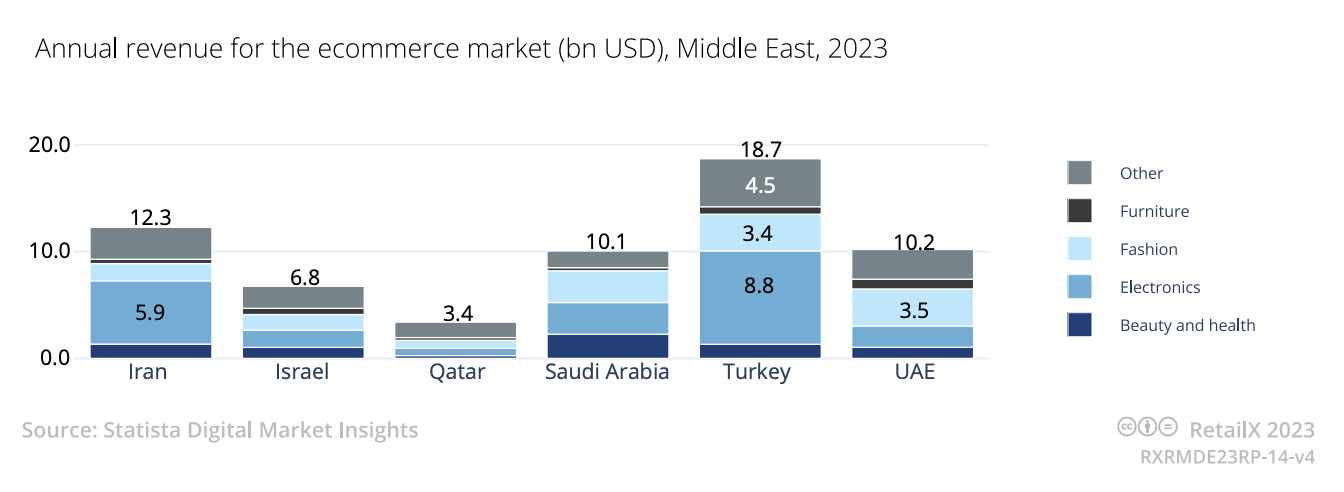
Changing Consumer Behavior, Digital Adoption Drive E-Commerce Surge in the Middle East
5. February 2024The Middle East is witnessing a dynamic shift in consumer behavior, preferences and digital adoption, prompting a transition towards online shopping and e-commerce, a new report by RetailX, a UK-based retail and e-commerce research company, says.
The report, titled “Middle East ecommerce region report 2023”, provides insight into the retail environment in the Middle East, looking in depth at shopper behaviors and consumer preferences across the region, and exploring the impact of the increasing use of digital channels on brick-and-mortar stores and payment preferences.
In particular, the report delves into six countries in particular, namely Iran, Israel, Qatar, Saudi Arabia, Turkey and the United Arab Emirates (UAE), to look at their similarities and differences, presenting key insights into the evolving landscape of online shopping and e-commerce in the Middle East.
A heterogenous region
Utilizing various international indices, the report assesses the digital maturity of the six markets and provides a snapshot of how easy it is for consumers to buy online along with the regulatory landscapes within which businesses operate.
The results show that Israel ranks among the global’s most mature digital economies and boasts a population that interacts with government agencies through online services underpinned by a well developed portal service.
Other countries reveal more varied scenarios. Iran, for example, has the largest compound annual growth rate (CAGR) for e-commerce revenue but accessing the Internet in terms of cost and the level of competition is among the worst in the region. Saudi Arabia and the UAE both score in the third quartile for the Affordability measure as well.
However, Iran excels in the Relevance and Readiness categories, which, respectively, assess the existence, extent and relevance of local language content online, and the population’s capacity to access the Internet.
Qatar and the UAE lead in the Internet Inclusive Index globally, ranking 25th and 27th, respectively. The other countries fall in the second quartile, with Iran being in the lowest position among the six Middle Eastern countries.
The growth of e-commerce
While brick-and-mortar retail remains the preferred shopping channel in the Middle East, there is a notable surge in e-commerce, growing at a faster rate than mature markets in Western Europe. This shift is attributed to substantial investments by retailers and shopping malls in e-commerce, customer experience and omnichannel retailing. These companies are leveraging technologies and techniques from global markets as well as those developed by the region’s own tech industries.
In Qatar, which currently boasts the highest prevalence of online shopping in terms of the amount of money spent by consumers, 85% of purchases were made in physical stores in 2023, marking a decline from 89% in 2019.

Revenue by channel for multichannel shoppers, Qatar, 2019-2023, Source: Middle East ecommerce region report 2023, RetailX, Nov 2023
In contrast, Turkey is the country in which multichannel shoppers are the least likely to choose online spending over shopping in a physical store. In 2023, 94% of customer spendings with retailers were spent in brick-and-mortar stores, compared to just 6% of revenue being spent online that year.

Revenue by channel for multichannel shoppers, Turkey, 2019-2023, Source: Middle East ecommerce region report 2023, RetailX, Nov 2023
Turkey is, however, the largest e-commerce market in the region, with consumers expected to spend US$18.7 billion online in 2023, almost twice the amount that consumers in the UAE will spend.

Annual revenue for the e-commerce market (US$), Middle East, 2023, Source: Middle East ecommerce region report 2023, RetailX, Nov 2023
Conversely, the UAE saw a rise in online spending from 8% in 2019 to 14% in 2023, marking one of the biggest jumps across the region.
E-commerce revenue in the UAE grew by a CAGR of 19.3% between 2019 and 2023, a strong growth that was fueled by active support from the government to help international companies settle in the country. For foreign tech players, the UAE oftentimes serves as an entry point for expansion into surrounding countries, with the Gulf Cooperation Council fostering economic ties, the report notes.
The country with the highest e-commerce growth rate between 2019 and 2023 is Iran, recording a CAGR of 31.7%. However, sanctions by the United Nations (UN) are making international trade challenging, it says.
Despite the growing e-commerce market, the report says that the Middle East is not yet a mature market, with 61% of Internet users shopping online and Internet usage standing at 80% of the population. These figures reveal tremendous untapped opportunities in the Middle East.
Mobile usage drives e-commerce growth
In the Middle East, e-commerce adoption is being driven by mobile usage and applications, with almost as much money being spent online using mobile phones and tablets than desktop devices.
The UAE currently has the highest adoption of mobile commerce. In 2023, 68% of online revenue in the country were made from consumers on mobile devices, making the channel the preferred way for local consumers to shop online.
Saudi Arabia and Turkey have lower levels of mobile commerce, though still considerable, with, respectively, 43% and 48% of e-commerce revenue originating from mobile purchases in 2023.

Device usage by revenue for e-commerce in Saudi Arabia and Turkey, 2019-2023, Source: Middle East ecommerce region report 2023, RetailX, Nov 2023
Social commerce picks up steam
Social commerce is another growing trend in the region that’s expected to pick up steam this year onwards. In 2023, social commerce is set to grow by 35%, with Saudi Arabia projected to have US$1.3 billion in sales on social media platforms during the year. The market is predicted to reach US$4.4 billion million by 2028, growing at a CAGR of 21.7%.
The rise of social commerce will be driven by the surge in e-commerce activity and the prominence of social media platforms in the Middle East. In Qatar, almost 98% of the population uses at least one social media platform.
In Turkey, 32.8 million users were on Facebook in early 2023, representing to just under half of the number of Internet users in the country. Out of the average of 7.5 hours a day using the internet, consumers in Turkey spent almost three hours on social media. A third of consumers said they used social media to find products to buy or to be inspired, while 35% follow their favorite brands or ones they are thinking of buying from. Turkey currently boasts one of the fastest growing digital advertising markets in the world.
Mobile payments surge in popularity
In the Middle East, debit and credit cards are the preferred payment method for online shopping, but usage varies across countries. In Turkey, 80% of online purchases are paid with a bank card, while in Saudi Arabia, only 36% of the value of online transactions is paid for with a bank card.
In both locations, digital wallets are rising in popularity. In Turkey, the rise of digital wallets is associated with the decline of cash on delivery. In 2023, electronic wallets, like ApplePay and PayPal, accounted for 4.35% of transactions by value in Turkey.

Payment type share by revenue for online shopping (%), Turkey, 2019-2023, Source: Middle East ecommerce region report 2023, RetailX, Nov 2023
Saudi Arabia boasts higher levels of digital wallet adoption. In 2023, 19% of the money spent online went via mobile wallets, making digital wallets the third most used payment method for online shopping, behind debit and credit cards (36%) and cash on delivery (22%).
These local nuances in payment methods are evident in the Middle East and emphasize the need for localization, the report says.

Payment type share by revenue for online shopping (%), Saudi Arabia, 2019-2023, Source: Middle East ecommerce region report 2023, RetailX, Nov 2023
Featured image credit: Edited from freepik






No Comments so far
Jump into a conversationNo Comments Yet!
You can be the one to start a conversation.